2
Ancient Hare History
The path of the hare is never simple. It is erratic, complex and much more ancient than people realise. By its very nature the quest is open ended with many unanswered questions. There are several different meanings to the Three Hares symbol, some of which may well have been lost over the course of time, others are conjecture, common sense and folklore. It is after all a symbol, and symbols can mean very different things to different people at different times in different cultures. The Three Hares are flexible and in motion, never staying still and that is the key to its success and long life. To some it is the Trinity, to others it is the Three Jewels of Buddhist teaching. It can be past, present and future; Vitality, Rebirth and Resurrection.
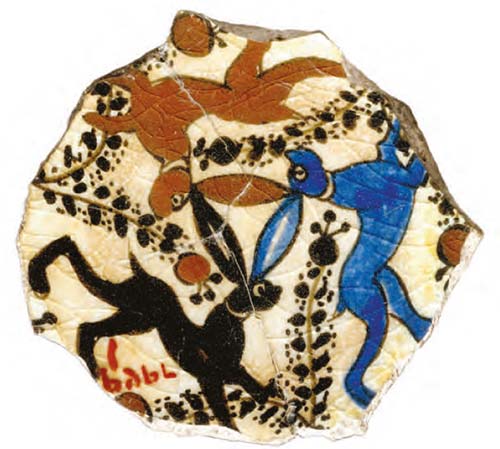
Egyptian or Syrian pottery fragment c1200AD Cairo Museum
The Three Hares have conjoined ears, each sharing an ear, and that in itself is a pleasing optical illusion. For some it is an intellectual journey in search of this remarkable symbol, for others a physical journey to track the hares down, document and where possible to photograph them.
In churches the Three Hares roof boss is often associated with the ‘Green Man’ whose head sprouts foliage – a dramatic and powerful male image familiar to many. The Three Hares can symbolise purity, lust and fertility, all in the same breath – quite an achievement – as well as good luck, and it can even give some measure of magical and psychological protection.
What is often overlooked is the triangle, the empty space that is left within the three ears of the three hares. Sometimes there is a dot in the centre. The inverted triangle is often seen as a feminine symbol which in India and Tibet has Tantric connotations. Tantric means ‘woven together’ in Sanskrit symbolising not only sexual union but union with the divine. The resemblance of the hare’s ears to the female vulva has not passed unnoticed to certain scholars and artists.
The sexual element to the Three Hares forever chasing each other has an attractive and universal appeal. Is this a secret coded acknowledgement to the enormous power of femininity? Is it a male hare chasing two female hares, or is it the other way round – two females chasing a male? Or three females? In some areas the hare was thought to be hermaphrodite, male one month and female the next. But one thing is for sure – they go round and round, and spiral off into infinity. One can only marvel at their endless, boundless energy.
There are other well known associations: the hare in the moon, mad March hares, dawn hares and the spring equinox. Easter bunnies and hares that are hunted. Shakespeare makes great use of conies and rabbits to entertain his audiences. Superstition also plays its part. Hares are an integral part of our culture from earliest times. Aphrodite was at times accompanied by a hare, and hares were often used for divination. The Roman historian Cassius Dio reports that before battle, Boudicca, Queen of the Iceni, who kept a hare close to her breast to keep her warm on winter’s days, would release a hare from the folds of her dress and see which way it ran to guide their attack. Live hares were also presented as gifts of love.
In ancient Egypt hares were very important. The god Osiris was sometimes portrayed with the head of a hare. The great river Nile which gave life to everyone through its annual floods and subsequent fertility was supposed to emanate from a mummified hare. The hieroglyph of the hare residing over a single ripple of water means ‘to be’ or ‘to exist’. So in a sense the hare could be taken to mean the source of the life force itself.
Osiris was therefore often depicted in the shape of a hare before being torn to pieces and thrown into the Nile to ensure the seasonal cycle of renewal. So the hare, the Nile, fertility and agriculture were one and the same. Bit like hare coursing. Poor hares always get it in the neck.
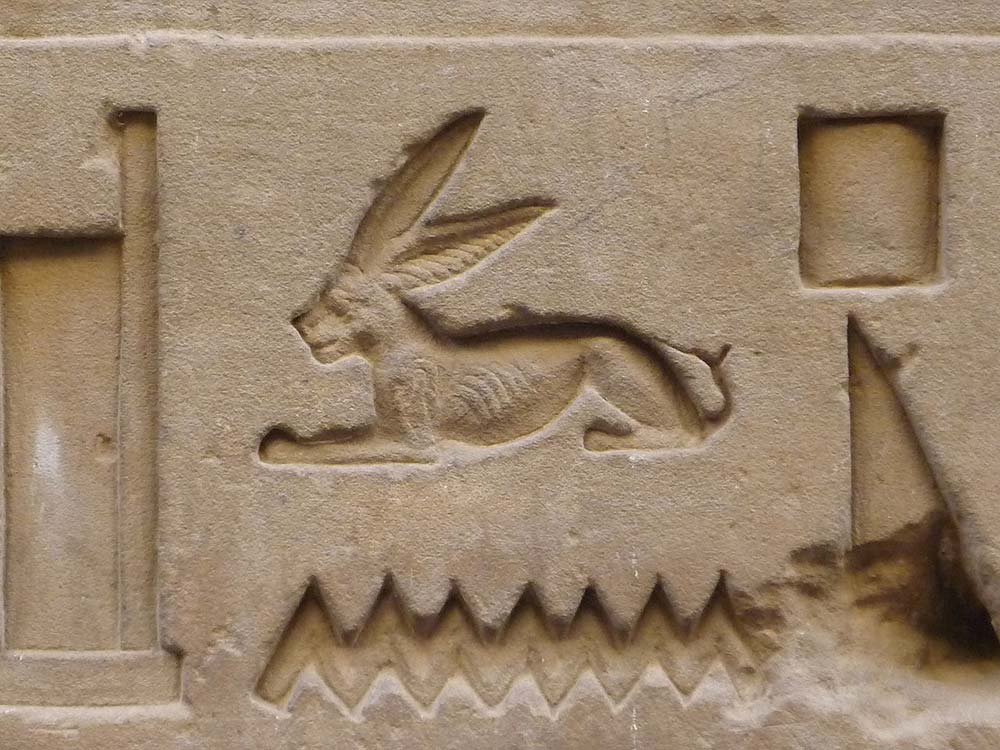
Stony faced Egyptian hare. To be or not to be…a hare surfing on the River Nile
Wall relief of a hare, temple of Edfu, Egypt. Photographer Rémih
Wikipedia
Osiris was also the God of the afterlife, underworld and the dead. Osiris was also God of Transition, Resurrection and Regeneration. He was linked to agriculture and the grain harvest in the same way that the seed of grain germinates and dies and then grain rises again and becomes an ear of wheat. Significantly Osiris holds a crook and a flail. Sheep and corn. The death of the god is celebrated at planting time and the resurrection at harvest. Osiris was also husband of Isis. Sometimes he was called Un nefer and wore the head of a hare as a mask and was sacrificed to the Nile each year to facilitate flooding which in turn led to an increase in soil fertility, irrigation and high grain yields. The hare was venerated for its swiftness and keen senses. There was also another goddess called Wenet the hare goddess who was Guardian of the underworld. She was taken into the cult of Horus and Ra. Egyptian mythology is complex but the hare plays a significant role within it, the downstream effects of which continued in the Middle East for two thousand years or more till the arrival of Christianity.
There are also Bronze Age Hittite hares from Syria running round in circles with double headed eagles. One stamp seal from the port city of Ugarit, now known as Ras Shamra, on the Mediterranean coast, (c.1800BC) has a hare in the centre alongside a man with a large helmet, then a ring of four hares and an outer ring of eight hares with other animals and birds interspersed.1
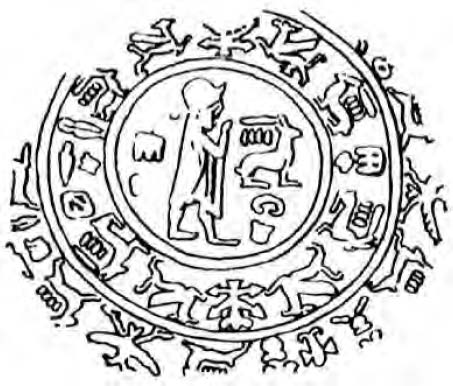
Hittite hare seal with eagles – Ugarit seal, C.1800BC
Ras Sharma is on the Syrian coast seven miles north of Latakia. The seal comes from the Imperial period (1480–1190BC). The city was destroyed in 1190BC and the whole empire came to an abrupt end ten years later in 1180BC. The Hittites were a very powerful people based at Hattusa north-eastern Anatolia. Their empire stretched over most of Turkey, Syria and the Levant. One great expert on Hittite seals was DG Hogarth of the Ashmolean who excavated at Charchemish before the First World War on the banks of the Euphrates. Seals both stamp and cylinder are common and were used on important documents for treaties with foreign powers or trade agreements.
Here the hare image occurs thirteen times on the seal. Something of a record. Hare and double-headed eagles often feature together in Hittite carvings and seals. Rundas, the Hittite god of the hunt and good fortune, is often represented in carvings by a glyph of a double-headed eagle with a hare in each talon.
Recently I sent a copy of the image to Dr Mark Weeden at SOAS who recognised it and identified the seal as “that of Taprammi (=LEPUS+ ra/i+mi), where the word for ‘hare’ in Luwian is ‘tapra-’. Taprammi is the name of a well-known official in the 13th century BC, from whom we have a number of other seal-impressions and inscriptions, including from the Hittite capital at Boğazköy (otherwise known as Hattusa)”.
“On this seal he is given the titles ‘Scribe’ (SCRIBA-la), ‘eunuch’ (where this does not necessarily mean that he had had his testicles removed but it is quite possible).”
My thanks to Dr Mark Wheeden for help in identifying this seal. So the linguistic symbolic language using the hare in Egypt was also alive and well in the Hittite empire c1300BC and it shows that there were important links between Ugarit and Hattusa hundreds of miles away in Northern Anatolia.
Also from the acropolis in Ugarit is a remarkable gold dish or patera showing four ibex in the centre with conjoined horns. This was found near the High Priest’s house and temple was found by the French archaeologist Claude Schaeffer in 1933 and is typical of the ‘international style’ of craftsmanship which flourished in the Levant, Cyprus and at the court of Egypt at this time (1500–1400BC).
See http://www.louvre.fr/en/oeuvre-notices/hunt-patera
This remarkable gold ceremonial dish or patera was one of a pair and was found near the High Priest’s house, behind a wall in the temple of Baal. Also in the High Priest’s house they found a library of mythological texts in Akkadian and in the local language. The two dishes were found behind the temenos wall. The other temple was that of Dagon. One dish is now in the Louvre, the other dish was left in the museum in Aleppo. One wonders where it is today. In the main outer frieze is the hunter, on a chariot drawn by two horses, accompanied by a dog. It is as if the ibex have been domesticated or tamed as they are walking round in a circle which animals do when they are treading out the corn. And on the outer rim is fabulous scene of the royal hunt. Offerings and libations.
Although made some two thousand years before the earliest known example of the Three Hares, the dish shows the strikingly similar ‘shared horns’ motif in the centre of a sacred vessel used for offerings or libations.3 On the outer rim is a royal chariot hunt. In the centre is a gold space between the horns which could symbolise either the sun, the full moon or even royal power. Priests were often used for ceremonies and sacrifices connected with agricultural events like ploughing, sowing and harvest. The transition from hunter-gatherer societies to agricultural based economies is pivotal to understanding the Middle East. Hares and harvests go together. Another remarkable gold cup was discovered in NW Iran with a frieze of gazelles. Early first millennium BC. Now in the Metropolitan Museum of New York.
See http://www.metmuseum.org/collection/the-collection-online/search/325511
Animals that were hunted were obviously of very high status indeed and these cups and plates and bowl may well have had a religious and political importance as well. Hares were obviously an important part of this quasi-religious animal world.
Long-eared rabbits or hares are often found in Syro-Hittite cylinder seals but rarely elsewhere. The hares are depicted as held in the hand as for food, or by itself. It is also abundant in Egyptian art and is an important hieroglyph.2
There is also a spectacular haematite cylinder seal with multiple hares on it which came up for sale at Christies recently. c1850BC
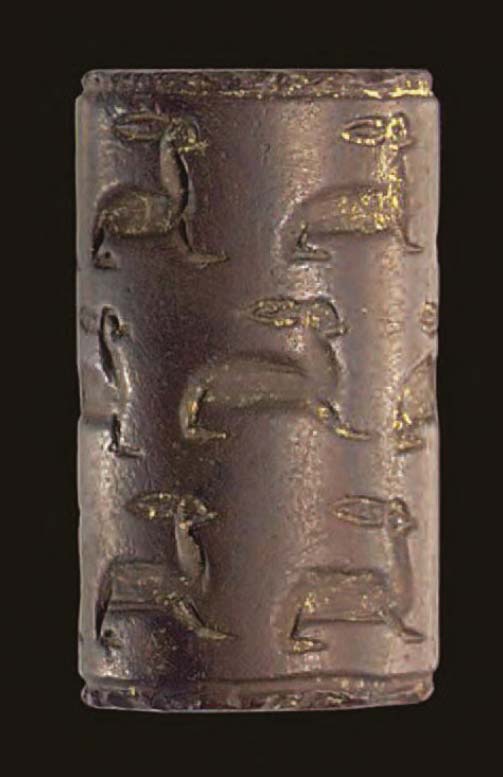
A Syrian Cylinder Seal, circa mid nineteenth-century BC from Christies
The first instance of Three Hares not in a circle but in a line that I have come across is on a rather strange bronze ceremonial object which is attributed to the Urartu/early Armenian kingdom in Eastern Turkey. There seem to be three prongs along which three different animals are seen to be running. Three wild boars, three hares and three mythical birds. There is a border of what looks like the edge of a field of wheat so this may well be linked to the transition to early agriculture where hares and other animals seek shelter in the field.
Three Urartu hares in a row. A similar style of three single hares are displayed on a Urartu bronze belt at the Ashmolean Museum Oxford.
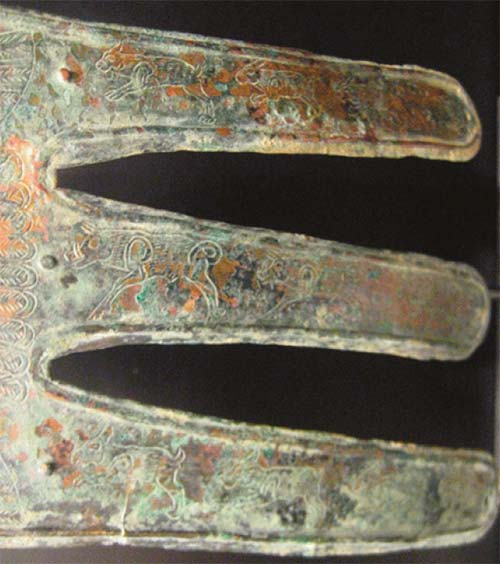
Top: Three Urartu/Armenian Hares c800BC © Barakat Galleries
Coins with Hare motif – Sicily, Messana, c480–412BC
To find out more about these remarkable and very pleasing Greek coins see:
http://www.coinarchives.com/a/results.php?results=100&search=mule
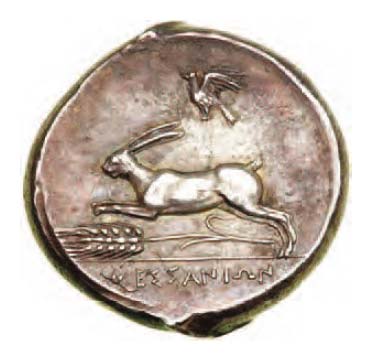
Hare with ear of barley and eagle hovering, Sicily, Messina, Silver Tetradrachm, c420BC
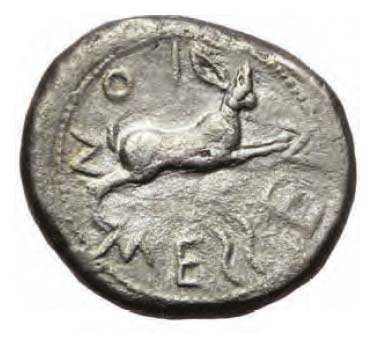
Sicily, Messina, Tetradrachm, c480–470BC; Bertolami Fine Arts – ACR Auctions > E-Auction 32
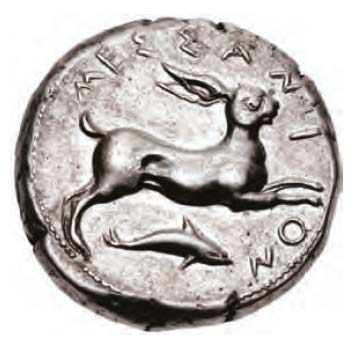
Hare with Dolphin Sicily, Messina Silver Tetradrachm c420–413BC Classical Numismatic Group. Triton IX lot 41
Three Hares are seen to be running in a row circa 900BC–600BC along with wild boar and mythical birds.4 The hare also appears Greek coins from Messina in Sicily c420BC.
So there is a distinct continuity in the use of hares on ceremonial objects in the Middle East over several thousand years. Historically the hare is therefore very important, fecund with meaning and worthy of investigation.
The transition from a single hare to three hares first in a line and then in a circle is key to this debate. Hares are also seen on coins with hunting eagles, doves, dolphins and even crabs. Sicily was fought over for many years and then finally became Norman in the 12th century AD. Today the hares crop up in Sicily in a four hare Islamic mosaic in the Duomo in Monreale south of Palermo and as three hares in a painting on the ceiling of the Cappella Palatina, Palermo.
No doubt more artefacts, images and associated information about hares in antiquity will emerge.
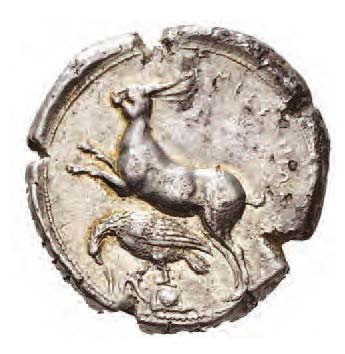
Greek tetradrachm of a hare leaping over an eagle which is having a tussle with a serpent c420BC